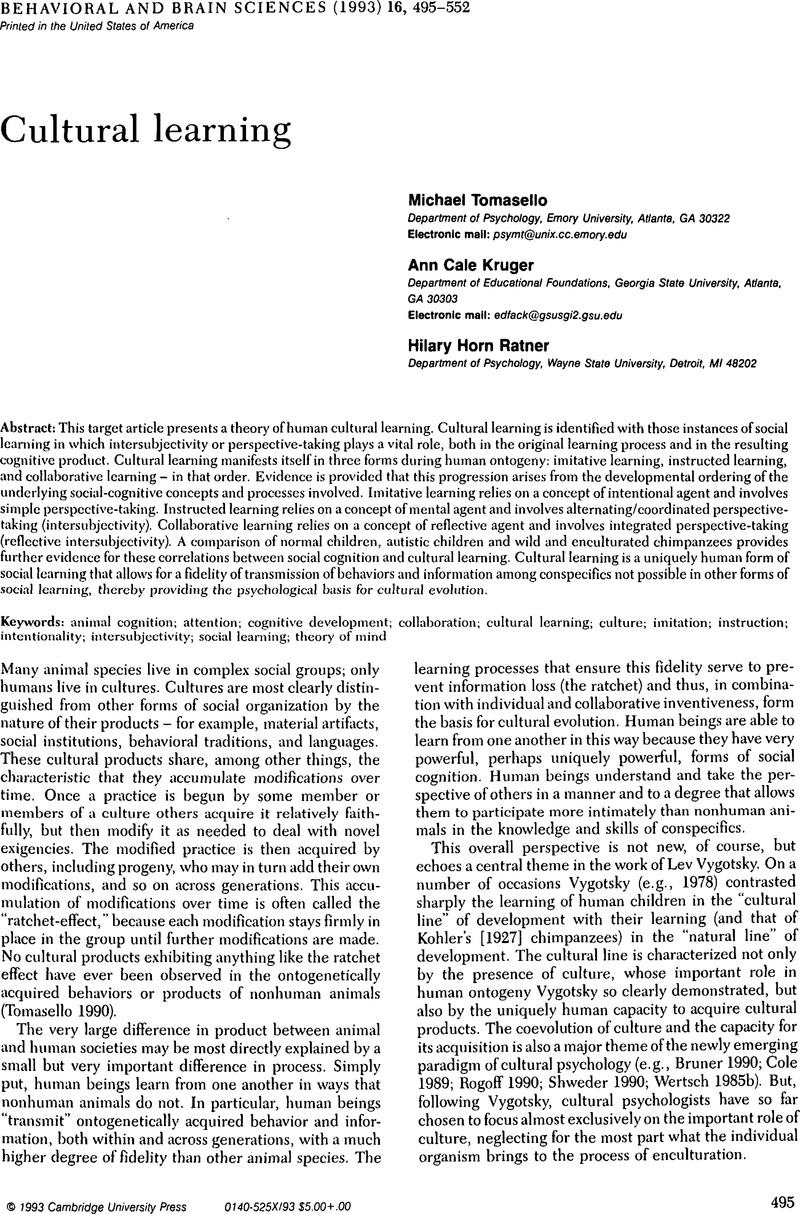Crossref Citations
This article has been cited by the following publications. This list is generated based on data provided by Crossref.
Pontecorvo, Clotilde
1994.
Rethinking learning processes and products.
Behavioral and Brain Sciences,
Vol. 17,
Issue. 4,
p.
780.
Call, J.
and
Tomasello, M.
1994.
The social learning of tool use by orangutans (Pongo pygmaeus).
Human Evolution,
Vol. 9,
Issue. 4,
p.
297.
Chisholm, James S.
and
Wescombe, Noel
1994.
Evolution, attachment, and cultural learning.
Behavioral and Brain Sciences,
Vol. 17,
Issue. 4,
p.
778.
Tomasello, Michael
Kruger, Ann Cale
and
Ratner, Hilary Horn
1994.
The role of emotions in cultural learning.
Behavioral and Brain Sciences,
Vol. 17,
Issue. 4,
p.
782.
Keller, Heidi
and
Chasiotis, Athanasios
1994.
“All I really need to know I learned in kindergarten” or is “cultural learning” anthropo-, ethno-, or adultocentric?.
Behavioral and Brain Sciences,
Vol. 17,
Issue. 4,
p.
779.
Boesch, Christophe
1995.
Innovation in wild chimpanzees (Pan troglodytes).
International Journal of Primatology,
Vol. 16,
Issue. 1,
p.
1.
Toomela, Aaro
1996.
How Culture Transforms Mind: A Process of Internalization.
Culture & Psychology,
Vol. 2,
Issue. 3,
p.
285.
Tomasello, Michael
2002.
Simulating the Evolution of Language.
p.
327.
Laland, Kevin N.
and
Hoppitt, William
2003.
Do animals have culture?.
Evolutionary Anthropology: Issues, News, and Reviews,
Vol. 12,
Issue. 3,
p.
150.
Bering, Jesse M.
2004.
A critical review of the ?enculturation hypothesis?: the effects of human rearing on great ape social cognition.
Animal Cognition,
Vol. 7,
Issue. 4,
p.
201.
Keller, Janet Dixon
2004.
Human cognitive ecology: an instructive framework for comparative primatology.
American Journal of Primatology,
Vol. 62,
Issue. 3,
p.
229.
Whiten, Andrew
Horner, Victoria
Litchfield, Carla A.
and
Marshall-Pescini, Sarah
2004.
How do apes ape?.
Learning & Behavior,
Vol. 32,
Issue. 1,
p.
36.
Lonsdorf, Elizabeth V.
2005.
Sex differences in the development of termite-fishing skills in the wild chimpanzees, Pan troglodytes schweinfurthii, of Gombe National Park, Tanzania.
Animal Behaviour,
Vol. 70,
Issue. 3,
p.
673.
Bering, Jesse M.
and
Bjorklund, David F.
2007.
The Cambridge Handbook of Consciousness.
Sayers, Ken
and
Lovejoy, C. Owen
2008.
The Chimpanzee Has No Clothes.
Current Anthropology,
Vol. 49,
Issue. 1,
p.
87.
Marshall-Pescini, Sarah
and
Whiten, Andrew
2008.
Chimpanzees (Pan troglodytes) and the question of cumulative culture: an experimental approach.
Animal Cognition,
Vol. 11,
Issue. 3,
p.
449.
Normand, Emmanuelle
Ban, Simone Dagui
and
Boesch, Christophe
2009.
Forest chimpanzees (Pan troglodytes verus) remember the location of numerous fruit trees.
Animal Cognition,
Vol. 12,
Issue. 6,
p.
797.
Bender, Courtney E.
Herzing, Denise L.
and
Bjorklund, David F.
2009.
Evidence of teaching in atlantic spotted dolphins (Stenella frontalis) by mother dolphins foraging in the presence of their calves.
Animal Cognition,
Vol. 12,
Issue. 1,
p.
43.
Kupán, Krisztina
Topál, József
and
Gergely, György
2009.
Az emberi kommunikatív jegyek értelmezése csecsemők és kutyák esetében – Összehasonlító vizsgálat.
Pszichológia,
Vol. 29,
Issue. 3,
p.
217.
Thornton, Alex
and
Clutton-Brock, Tim
2011.
Social learning and the development of individual and group behaviour in mammal societies.
Philosophical Transactions of the Royal Society B: Biological Sciences,
Vol. 366,
Issue. 1567,
p.
978.



